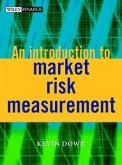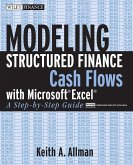- Gebundenes Buch
- Merkliste
- Auf die Merkliste
- Bewerten Bewerten
- Teilen
- Produkt teilen
- Produkterinnerung
- Produkterinnerung
Corporate actions are events that affect large corporations through to the individual investor - even those that own a single-share! All organizations that hold equity and debt securities for themselves and/or on behalf of others are affected when the issuer of a security announces an income or corporate action event. The successful management of the array of different event types requires understanding of the inherent risks, and tight controls at critical points in the event lifecycle. The management of income and corporate action events are important and essential parts of the securities…mehr
Andere Kunden interessierten sich auch für
![An Introduction to Market Risk Measurement An Introduction to Market Risk Measurement]() Kevin DowdAn Introduction to Market Risk Measurement100,99 €
Kevin DowdAn Introduction to Market Risk Measurement100,99 €![Capital Asset Investment Capital Asset Investment]() Anthony F. HerbstCapital Asset Investment182,99 €
Anthony F. HerbstCapital Asset Investment182,99 €![Modeling Structured Finance Cash Flows with Microsoft Excel Modeling Structured Finance Cash Flows with Microsoft Excel]() Keith A. AllmanModeling Structured Finance Cash Flows with Microsoft Excel79,99 €
Keith A. AllmanModeling Structured Finance Cash Flows with Microsoft Excel79,99 €![Investor Behavior Investor Behavior]() H. Kent BakerInvestor Behavior117,99 €
H. Kent BakerInvestor Behavior117,99 €![Goals-Based Wealth Management Goals-Based Wealth Management]() Jean L. P. BrunelGoals-Based Wealth Management50,99 €
Jean L. P. BrunelGoals-Based Wealth Management50,99 €![Leadership Risk Leadership Risk]() David CooperLeadership Risk69,99 €
David CooperLeadership Risk69,99 €![The Principles of Banking The Principles of Banking]() Moorad ChoudhryThe Principles of Banking104,99 €
Moorad ChoudhryThe Principles of Banking104,99 €-
-
-
Corporate actions are events that affect large corporations through to the individual investor - even those that own a single-share! All organizations that hold equity and debt securities for themselves and/or on behalf of others are affected when the issuer of a security announces an income or corporate action event. The successful management of the array of different event types requires understanding of the inherent risks, and tight controls at critical points in the event lifecycle. The management of income and corporate action events are important and essential parts of the securities industry business. Written by authors with many years experience within this sector, Corporate Actions: A Guide to Securities Event Management sets out to demystify the subject and provides a thorough, step-by-step introduction to corporate actions and income events.
Corporate Actions is a comprehensive source for understanding a major component of operational processing. The individualcomponents and their relation to each other within the corporate actions lifecycle are explained in detail, through which the reader will gain a clear and thorough understanding of the lifecycle together with potential processing risks and the strategies to mitigate
Corporate Actions is essential reading for all those involved in the securities industry, from new recruits to those involved in both the day-to-day operations process and those within executive management. It will also prove invaluable to those providing consultancy and software solutions to the securities industry.
Corporate Actions is the first major work on this subject. Many people within the securities industry have heard of corporate actions - many people know they can be highly risky - many organizations have lost vast sums of cash in attempting to process them - very few understand them!
Hinweis: Dieser Artikel kann nur an eine deutsche Lieferadresse ausgeliefert werden.
Corporate Actions is a comprehensive source for understanding a major component of operational processing. The individualcomponents and their relation to each other within the corporate actions lifecycle are explained in detail, through which the reader will gain a clear and thorough understanding of the lifecycle together with potential processing risks and the strategies to mitigate
Corporate Actions is essential reading for all those involved in the securities industry, from new recruits to those involved in both the day-to-day operations process and those within executive management. It will also prove invaluable to those providing consultancy and software solutions to the securities industry.
Corporate Actions is the first major work on this subject. Many people within the securities industry have heard of corporate actions - many people know they can be highly risky - many organizations have lost vast sums of cash in attempting to process them - very few understand them!
Hinweis: Dieser Artikel kann nur an eine deutsche Lieferadresse ausgeliefert werden.
Produktdetails
- Produktdetails
- Wiley Finance Series
- Verlag: Wiley & Sons
- Artikelnr. des Verlages: 14587066000
- 1. Auflage
- Seitenzahl: 432
- Erscheinungstermin: 1. März 2006
- Englisch
- Abmessung: 250mm x 175mm x 27mm
- Gewicht: 980g
- ISBN-13: 9780470870662
- ISBN-10: 0470870664
- Artikelnr.: 13057493
- Herstellerkennzeichnung
- Libri GmbH
- Europaallee 1
- 36244 Bad Hersfeld
- gpsr@libri.de
- Wiley Finance Series
- Verlag: Wiley & Sons
- Artikelnr. des Verlages: 14587066000
- 1. Auflage
- Seitenzahl: 432
- Erscheinungstermin: 1. März 2006
- Englisch
- Abmessung: 250mm x 175mm x 27mm
- Gewicht: 980g
- ISBN-13: 9780470870662
- ISBN-10: 0470870664
- Artikelnr.: 13057493
- Herstellerkennzeichnung
- Libri GmbH
- Europaallee 1
- 36244 Bad Hersfeld
- gpsr@libri.de
Michael was raised middleclass in Massachusetts. He was a gifted athlete but struggled academically. He went to college on a lacrosse scholarship. During his second semester he experienced a spontaneous spiritual event known as a kundalini awakening. The traumatic event caused several symptoms of mental illness and forced him to leave school. He struggled with his spiritual awakening and drug and alcohol abuse for the next ten years. During this time, he took a kundalini teacher training course under the late Yogi Bhajan, received a biotechnology degree, and a bachelor's degree in biology. Eventually, Michael used orthomolecular therapy to repair his body and brain which allowed him to come off his medications.Kundalini energy is a natural part of the human body. The spiritual experience had a profound effect on Michael. He became smarter, ambitious, and it left him with a compulsion to learn. He believes through direct observation that this spiritual energy is used to unify the consciousness of the body with the "I am" or normal consciousness of the mind. Michael briefly worked in industries germane to his degrees. He also worked for adults struggling with mental illness as a health and wellness coordinator. It was working with this group of individuals that Michael was able to see the consequences and causes of poverty. Malnourishment, drug addiction, unstable living conditions and the absence of a support system were common challenges to their financial independence
Introduction xvii
Acknowledgements xxi
About the Authors xxiii
Part I Introductory Elements 1
1 Basic Corporate Action Concepts 3
1.1 Introduction 3
1.2 Definition of Corporate Actions 3
1.3 Purpose of Corporate Actions 3
1.4 Impact of Corporate Actions 5
1.5 The Lifecycle of a Corporate Action 6
1.6 Summary 8
2 Event Description and Classification 9
2.1 Introduction 9
2.2 Event Descriptions 9
2.3 Event Classification 19
2.4 Event Combinations 20
2.5 Event Variations and Terminology 22
2.6 Summary 22
3 The Securities (and Corporate Actions) Market Place 23
3.1 Introduction 23
3.2 The Securities Market Place - Overview 23
3.3 Participants - The Corporate Actions Perspective 31
3.4 Summary 36
4 Static Data 37
4.1 Introduction 37
4.2 Securities Static Data 37
4.3 Participant Static Data 41
4.4 Sources and Maintenance of Static Data 45
4.5 Summary 47
5 Securities Position Management 49
5.1 Introduction 49
5.2 The STO'S Risk 49
5.3 Fundamentals of Securities Position Management 50
5.4 Generic Securities Accounting Principles 52
5.5 Extended Securities Position Management 53
5.6 Disparate Trade and Position Records 54
5.7 Reconciliation 54
5.8 Summary 55
Part II Mandatory Events 57
6 Overview of the Generic Corporate Action Lifecycle 59
6.1 Introduction 59
6.2 Issuer Communicates Event Data 60
6.3 Event Terms Capture and Cleansing 60
6.4 Determining Entitlement 60
6.5 Communication of Event Information 60
6.6 Calculation of Resultant Entitlements 60
6.7 Passing of Internal Entries 61
6.8 Collection and Disbursement of Resultant Entitlements 61
6.9 Updating of Internal Entries 61
7 Straight Through Processing 63
7.1 Introduction 63
7.2 STP and Corporate Actions 64
8 Event Terms Capture and Cleansing 67
8.1 Introduction 67
8.2 Event Terms 68
8.3 Sources of Event Terms 72
8.4 Availability of Event Terms 73
8.5 Cleansing of Event Terms 74
8.6 When to Apply Event Terms 76
8.7 Managing Changes to Event Terms Throughout the Lifecycle 76
8.8 Summary 77
9 Determining Entitlement 79
9.1 Introduction 79
9.2 The STO's Risk 80
9.3 Types of Entitled Positions (Including Unsettled Trades) 80
9.4 Links Between Ownership Positions and Location Positions 84
9.5 Equity Event Entitlement Business Principles 84
9.6 Equity Event - Itemized Trading and Settlement Scenarios 92
9.7 Bonds Event Entitlement Business Principles 94
9.8 Applying the Business Principles in Practice 97
9.9 Balancing of Positions and Unsettled Trades 105
9.10 Reconciliation of Positions and Unsettled Trades 109
9.11 Summary 111
10 Communication of Event Information 113
10.1 Introduction 113
10.2 The STO's Risk 114
10.3 Communicating with Position Holders 114
10.4 Communicating with Interested Parties 120
10.5 Summary 121
11 Calculation of Resultant Entitlements 123
11.1 Introduction 123
11.2 The STO's Risk 124
11.3 Calculation of Resultant Cash Entitlements 125
11.4 Calculation of Resultant Securities Entitlements 126
11.5 Calculation of Resultant Entitlements Against Ownership Positions 130
11.6 Balancing Resultant Entitlements 132
11.7 Reconciliation of Resultant Entitlements 134
11.8 Determination of Collectible and Disbursable Accounts 136
11.9 Summary 136
12 Passing of Internal Entries 139
12.1 Introduction 139
12.2 The STO's Risk 139
12.3 Mechanisms for Passing Internal Entries 140
12.4 Types of Internal Entries 141
12.5 Review of Required Internal Entries 149
12.6 Summary 150
13 Collection/Disbursement of Resultant Entitlements 151
13.1 Introduction 151
13.2 The STO's Risk 152
13.3 Collection of Resultant Entitlements from the Custodian 153
13.4 Disbursement of Resultant Entitlements to Position Holders 154
13.5 Settlement of Claims 157
13.6 Write-Offs 160
13.7 Summary 160
14 Updating of Internal Entries 161
14.1 Introduction 161
14.2 The STO's Risk 161
14.3 Mechanisms for Passing Internal Entries 162
14.4 Settlement Date Entries 162
14.5 Settlement of Claims and Transformations 166
14.6 Summary 166
15 Examples of Mandatory Events 167
15.1 Introduction 167
15.2 Bonus Issue 167
15.3 Share Split 174
15.4 Bond Maturity 179
Part III Events with Elections 185
16 Concepts of Events with Elections 187
16.1 Introduction 187
16.2 The STO's Risk 188
16.3 Impact of Events with Elections 188
16.4 Events with Elections Lifecycle 190
16.5 Summary 191
17 Management of Mandatory with Options Events 193
17.1 Introduction 193
17.2 Mandatory with Options Event Terms 194
17.3 Determining Entitlement to Mandatory with Options Events 196
17.4 Communication of Mandatory with Options Event Information 196
17.5 Receipt of Election Decisions 198
17.6 Recording and Validating Received Election Decisions 200
17.7 Managing Overdue Election Decisions 202
17.8 Issue of Election Decisions 203
17.9 Over-Elections 209
17.10 Calculation of Resultant Entitlements 211
17.11 Passing of Internal Entries 214
17.12 Collection and Disbursement of Resultant Entitlements 217
17.13 Updating of Internal Entries 217
17.14 Summary 217
18 Management of Voluntary Events 219
18.1 Introduction 219
18.2 Voluntary Event Terms 220
18.3 Determining Entitlement to Voluntary Events 221
18.4 Communication of Voluntary Event Information 222
18.5 Receipt of Election Decisions 222
18.6 Recording and Validating Received Election Decisions 223
18.7 Managing Overdue Election Decisions 224
18.8 Issue of Election Decisions 225
18.9 Over-elections 225
18.10 Calculation of Resultant Entitlements 225
18.11 Passing of Internal Entries 227
18.12 Collection and Disbursement of Resultant Entitlements 231
18.13 Updating of Internal Entries 231
18.14 Summary 231
Part IV Multi-stage Events 233
19 Concepts of Multi-Stage Events 235
19.1 Introduction 235
19.2 The Life of a Multi-stage Event 235
19.3 The STO's Risk 239
19.4 Impact of Multi-stage Events 239
19.5 Lifecycle Elements of the Multi-stage Event 241
19.6 Summary 246
20 Management of a Rights Issue 247
20.1 Introduction 247
20.2 The Operational Life of a Rights Issue 247
20.3 Rights Issue Event Terms 248
20.4 Nil Paid Rights Distribution 250
20.5 Nil Paid Rights Subscription 253
20.6 Un-subscribed Nil Paid Rights Expiry 258
20.7 Summary 259
21 Example of a Rights Issue 261
21.1 Introduction 261
21.2 Event Terms 261
21.3 Nil Paid Rights Distribution 262
21.4 Nil Paid Rights Trading 266
21.5 Nil Paid Rights Subscription 266
21.6 Unsubscribed Nil Paid Rights Expiry 272
21.7 Final Securities Positions 273
22 Concepts of Takeover Events 275
22.1 Introduction 275
22.2 The STO's Risk 276
22.3 Features of Takeovers 276
22.4 Impact of Takeover Events 281
22.5 Takeover Event Lifecycle 284
22.6 Summary 284
23 Management of Takeover Events 285
23.1 Takeover Event Terms 285
23.2 Determining Entitlement to Takeover Events 288
23.3 Communication of Event Information 289
23.4 Management of Election Decisions 290
23.5 Managing Unsuccessful Takeovers 291
23.6 Over-Acceptances 291
23.7 Calculation of Resultant Entitlements 293
23.8 Passing of Internal Entries 296
23.9 Collection and Disbursement of Resultant Entitlements 297
23.10 Updating of Internal Entries 298
23.11 Summary 298
Part V Taxation 299
24 Concepts and Management of Taxation 301
24.1 Introduction 301
24.2 Taxable and Non-Taxable Events 301
24.3 Introduction to Capital Gains Tax and Income Tax 302
24.4 The STO's Risk 305
24.5 Summary 305
25 Management of Income Tax 307
25.1 Introduction 307
25.2 Gross Income 308
25.3 Foreign Witholding Tax 309
25.4 Net Income After Deduction of Foreign Withholding Tax 310
25.5 Position Holder's Domestic Income Tax 310
25.6 Net Income After Deduction of Foreign Withholding Tax and Position
Holder's Domestic Income Tax 313
25.7 Determining Tax Rates for Position Holders 318
25.8 Ensuring Correct Withholding Tax is Deducted by the Location 321
25.9 The STO as Collector of Taxes 322
25.10 Tax Reclaims and Tax Rebates 323
25.11 Communicating Income and Tax Details 326
25.12 Summary 329
Part VI Issuer Notices 331
26 Concepts and Management of Issuer Notices 333
26.1 Introduction 333
26.2 The STO's Risk 333
26.3 Information Only Events 334
26.4 Issuer Meetings with Proxy Voting Events 335
26.5 Summary 339
Part VII Objectives and Initiatives 341
27 Objectives and Initiatives 343
27.1 Introduction 343
27.2 Objectives 343
27.3 Initiatives to Achieve the Stated Objectives 345
27.4 Challenges in Achieving the Stated Objectives 351
Glossary of Terms 353
Index 383
Acknowledgements xxi
About the Authors xxiii
Part I Introductory Elements 1
1 Basic Corporate Action Concepts 3
1.1 Introduction 3
1.2 Definition of Corporate Actions 3
1.3 Purpose of Corporate Actions 3
1.4 Impact of Corporate Actions 5
1.5 The Lifecycle of a Corporate Action 6
1.6 Summary 8
2 Event Description and Classification 9
2.1 Introduction 9
2.2 Event Descriptions 9
2.3 Event Classification 19
2.4 Event Combinations 20
2.5 Event Variations and Terminology 22
2.6 Summary 22
3 The Securities (and Corporate Actions) Market Place 23
3.1 Introduction 23
3.2 The Securities Market Place - Overview 23
3.3 Participants - The Corporate Actions Perspective 31
3.4 Summary 36
4 Static Data 37
4.1 Introduction 37
4.2 Securities Static Data 37
4.3 Participant Static Data 41
4.4 Sources and Maintenance of Static Data 45
4.5 Summary 47
5 Securities Position Management 49
5.1 Introduction 49
5.2 The STO'S Risk 49
5.3 Fundamentals of Securities Position Management 50
5.4 Generic Securities Accounting Principles 52
5.5 Extended Securities Position Management 53
5.6 Disparate Trade and Position Records 54
5.7 Reconciliation 54
5.8 Summary 55
Part II Mandatory Events 57
6 Overview of the Generic Corporate Action Lifecycle 59
6.1 Introduction 59
6.2 Issuer Communicates Event Data 60
6.3 Event Terms Capture and Cleansing 60
6.4 Determining Entitlement 60
6.5 Communication of Event Information 60
6.6 Calculation of Resultant Entitlements 60
6.7 Passing of Internal Entries 61
6.8 Collection and Disbursement of Resultant Entitlements 61
6.9 Updating of Internal Entries 61
7 Straight Through Processing 63
7.1 Introduction 63
7.2 STP and Corporate Actions 64
8 Event Terms Capture and Cleansing 67
8.1 Introduction 67
8.2 Event Terms 68
8.3 Sources of Event Terms 72
8.4 Availability of Event Terms 73
8.5 Cleansing of Event Terms 74
8.6 When to Apply Event Terms 76
8.7 Managing Changes to Event Terms Throughout the Lifecycle 76
8.8 Summary 77
9 Determining Entitlement 79
9.1 Introduction 79
9.2 The STO's Risk 80
9.3 Types of Entitled Positions (Including Unsettled Trades) 80
9.4 Links Between Ownership Positions and Location Positions 84
9.5 Equity Event Entitlement Business Principles 84
9.6 Equity Event - Itemized Trading and Settlement Scenarios 92
9.7 Bonds Event Entitlement Business Principles 94
9.8 Applying the Business Principles in Practice 97
9.9 Balancing of Positions and Unsettled Trades 105
9.10 Reconciliation of Positions and Unsettled Trades 109
9.11 Summary 111
10 Communication of Event Information 113
10.1 Introduction 113
10.2 The STO's Risk 114
10.3 Communicating with Position Holders 114
10.4 Communicating with Interested Parties 120
10.5 Summary 121
11 Calculation of Resultant Entitlements 123
11.1 Introduction 123
11.2 The STO's Risk 124
11.3 Calculation of Resultant Cash Entitlements 125
11.4 Calculation of Resultant Securities Entitlements 126
11.5 Calculation of Resultant Entitlements Against Ownership Positions 130
11.6 Balancing Resultant Entitlements 132
11.7 Reconciliation of Resultant Entitlements 134
11.8 Determination of Collectible and Disbursable Accounts 136
11.9 Summary 136
12 Passing of Internal Entries 139
12.1 Introduction 139
12.2 The STO's Risk 139
12.3 Mechanisms for Passing Internal Entries 140
12.4 Types of Internal Entries 141
12.5 Review of Required Internal Entries 149
12.6 Summary 150
13 Collection/Disbursement of Resultant Entitlements 151
13.1 Introduction 151
13.2 The STO's Risk 152
13.3 Collection of Resultant Entitlements from the Custodian 153
13.4 Disbursement of Resultant Entitlements to Position Holders 154
13.5 Settlement of Claims 157
13.6 Write-Offs 160
13.7 Summary 160
14 Updating of Internal Entries 161
14.1 Introduction 161
14.2 The STO's Risk 161
14.3 Mechanisms for Passing Internal Entries 162
14.4 Settlement Date Entries 162
14.5 Settlement of Claims and Transformations 166
14.6 Summary 166
15 Examples of Mandatory Events 167
15.1 Introduction 167
15.2 Bonus Issue 167
15.3 Share Split 174
15.4 Bond Maturity 179
Part III Events with Elections 185
16 Concepts of Events with Elections 187
16.1 Introduction 187
16.2 The STO's Risk 188
16.3 Impact of Events with Elections 188
16.4 Events with Elections Lifecycle 190
16.5 Summary 191
17 Management of Mandatory with Options Events 193
17.1 Introduction 193
17.2 Mandatory with Options Event Terms 194
17.3 Determining Entitlement to Mandatory with Options Events 196
17.4 Communication of Mandatory with Options Event Information 196
17.5 Receipt of Election Decisions 198
17.6 Recording and Validating Received Election Decisions 200
17.7 Managing Overdue Election Decisions 202
17.8 Issue of Election Decisions 203
17.9 Over-Elections 209
17.10 Calculation of Resultant Entitlements 211
17.11 Passing of Internal Entries 214
17.12 Collection and Disbursement of Resultant Entitlements 217
17.13 Updating of Internal Entries 217
17.14 Summary 217
18 Management of Voluntary Events 219
18.1 Introduction 219
18.2 Voluntary Event Terms 220
18.3 Determining Entitlement to Voluntary Events 221
18.4 Communication of Voluntary Event Information 222
18.5 Receipt of Election Decisions 222
18.6 Recording and Validating Received Election Decisions 223
18.7 Managing Overdue Election Decisions 224
18.8 Issue of Election Decisions 225
18.9 Over-elections 225
18.10 Calculation of Resultant Entitlements 225
18.11 Passing of Internal Entries 227
18.12 Collection and Disbursement of Resultant Entitlements 231
18.13 Updating of Internal Entries 231
18.14 Summary 231
Part IV Multi-stage Events 233
19 Concepts of Multi-Stage Events 235
19.1 Introduction 235
19.2 The Life of a Multi-stage Event 235
19.3 The STO's Risk 239
19.4 Impact of Multi-stage Events 239
19.5 Lifecycle Elements of the Multi-stage Event 241
19.6 Summary 246
20 Management of a Rights Issue 247
20.1 Introduction 247
20.2 The Operational Life of a Rights Issue 247
20.3 Rights Issue Event Terms 248
20.4 Nil Paid Rights Distribution 250
20.5 Nil Paid Rights Subscription 253
20.6 Un-subscribed Nil Paid Rights Expiry 258
20.7 Summary 259
21 Example of a Rights Issue 261
21.1 Introduction 261
21.2 Event Terms 261
21.3 Nil Paid Rights Distribution 262
21.4 Nil Paid Rights Trading 266
21.5 Nil Paid Rights Subscription 266
21.6 Unsubscribed Nil Paid Rights Expiry 272
21.7 Final Securities Positions 273
22 Concepts of Takeover Events 275
22.1 Introduction 275
22.2 The STO's Risk 276
22.3 Features of Takeovers 276
22.4 Impact of Takeover Events 281
22.5 Takeover Event Lifecycle 284
22.6 Summary 284
23 Management of Takeover Events 285
23.1 Takeover Event Terms 285
23.2 Determining Entitlement to Takeover Events 288
23.3 Communication of Event Information 289
23.4 Management of Election Decisions 290
23.5 Managing Unsuccessful Takeovers 291
23.6 Over-Acceptances 291
23.7 Calculation of Resultant Entitlements 293
23.8 Passing of Internal Entries 296
23.9 Collection and Disbursement of Resultant Entitlements 297
23.10 Updating of Internal Entries 298
23.11 Summary 298
Part V Taxation 299
24 Concepts and Management of Taxation 301
24.1 Introduction 301
24.2 Taxable and Non-Taxable Events 301
24.3 Introduction to Capital Gains Tax and Income Tax 302
24.4 The STO's Risk 305
24.5 Summary 305
25 Management of Income Tax 307
25.1 Introduction 307
25.2 Gross Income 308
25.3 Foreign Witholding Tax 309
25.4 Net Income After Deduction of Foreign Withholding Tax 310
25.5 Position Holder's Domestic Income Tax 310
25.6 Net Income After Deduction of Foreign Withholding Tax and Position
Holder's Domestic Income Tax 313
25.7 Determining Tax Rates for Position Holders 318
25.8 Ensuring Correct Withholding Tax is Deducted by the Location 321
25.9 The STO as Collector of Taxes 322
25.10 Tax Reclaims and Tax Rebates 323
25.11 Communicating Income and Tax Details 326
25.12 Summary 329
Part VI Issuer Notices 331
26 Concepts and Management of Issuer Notices 333
26.1 Introduction 333
26.2 The STO's Risk 333
26.3 Information Only Events 334
26.4 Issuer Meetings with Proxy Voting Events 335
26.5 Summary 339
Part VII Objectives and Initiatives 341
27 Objectives and Initiatives 343
27.1 Introduction 343
27.2 Objectives 343
27.3 Initiatives to Achieve the Stated Objectives 345
27.4 Challenges in Achieving the Stated Objectives 351
Glossary of Terms 353
Index 383
Introduction xvii
Acknowledgements xxi
About the Authors xxiii
Part I Introductory Elements 1
1 Basic Corporate Action Concepts 3
1.1 Introduction 3
1.2 Definition of Corporate Actions 3
1.3 Purpose of Corporate Actions 3
1.4 Impact of Corporate Actions 5
1.5 The Lifecycle of a Corporate Action 6
1.6 Summary 8
2 Event Description and Classification 9
2.1 Introduction 9
2.2 Event Descriptions 9
2.3 Event Classification 19
2.4 Event Combinations 20
2.5 Event Variations and Terminology 22
2.6 Summary 22
3 The Securities (and Corporate Actions) Market Place 23
3.1 Introduction 23
3.2 The Securities Market Place - Overview 23
3.3 Participants - The Corporate Actions Perspective 31
3.4 Summary 36
4 Static Data 37
4.1 Introduction 37
4.2 Securities Static Data 37
4.3 Participant Static Data 41
4.4 Sources and Maintenance of Static Data 45
4.5 Summary 47
5 Securities Position Management 49
5.1 Introduction 49
5.2 The STO'S Risk 49
5.3 Fundamentals of Securities Position Management 50
5.4 Generic Securities Accounting Principles 52
5.5 Extended Securities Position Management 53
5.6 Disparate Trade and Position Records 54
5.7 Reconciliation 54
5.8 Summary 55
Part II Mandatory Events 57
6 Overview of the Generic Corporate Action Lifecycle 59
6.1 Introduction 59
6.2 Issuer Communicates Event Data 60
6.3 Event Terms Capture and Cleansing 60
6.4 Determining Entitlement 60
6.5 Communication of Event Information 60
6.6 Calculation of Resultant Entitlements 60
6.7 Passing of Internal Entries 61
6.8 Collection and Disbursement of Resultant Entitlements 61
6.9 Updating of Internal Entries 61
7 Straight Through Processing 63
7.1 Introduction 63
7.2 STP and Corporate Actions 64
8 Event Terms Capture and Cleansing 67
8.1 Introduction 67
8.2 Event Terms 68
8.3 Sources of Event Terms 72
8.4 Availability of Event Terms 73
8.5 Cleansing of Event Terms 74
8.6 When to Apply Event Terms 76
8.7 Managing Changes to Event Terms Throughout the Lifecycle 76
8.8 Summary 77
9 Determining Entitlement 79
9.1 Introduction 79
9.2 The STO's Risk 80
9.3 Types of Entitled Positions (Including Unsettled Trades) 80
9.4 Links Between Ownership Positions and Location Positions 84
9.5 Equity Event Entitlement Business Principles 84
9.6 Equity Event - Itemized Trading and Settlement Scenarios 92
9.7 Bonds Event Entitlement Business Principles 94
9.8 Applying the Business Principles in Practice 97
9.9 Balancing of Positions and Unsettled Trades 105
9.10 Reconciliation of Positions and Unsettled Trades 109
9.11 Summary 111
10 Communication of Event Information 113
10.1 Introduction 113
10.2 The STO's Risk 114
10.3 Communicating with Position Holders 114
10.4 Communicating with Interested Parties 120
10.5 Summary 121
11 Calculation of Resultant Entitlements 123
11.1 Introduction 123
11.2 The STO's Risk 124
11.3 Calculation of Resultant Cash Entitlements 125
11.4 Calculation of Resultant Securities Entitlements 126
11.5 Calculation of Resultant Entitlements Against Ownership Positions 130
11.6 Balancing Resultant Entitlements 132
11.7 Reconciliation of Resultant Entitlements 134
11.8 Determination of Collectible and Disbursable Accounts 136
11.9 Summary 136
12 Passing of Internal Entries 139
12.1 Introduction 139
12.2 The STO's Risk 139
12.3 Mechanisms for Passing Internal Entries 140
12.4 Types of Internal Entries 141
12.5 Review of Required Internal Entries 149
12.6 Summary 150
13 Collection/Disbursement of Resultant Entitlements 151
13.1 Introduction 151
13.2 The STO's Risk 152
13.3 Collection of Resultant Entitlements from the Custodian 153
13.4 Disbursement of Resultant Entitlements to Position Holders 154
13.5 Settlement of Claims 157
13.6 Write-Offs 160
13.7 Summary 160
14 Updating of Internal Entries 161
14.1 Introduction 161
14.2 The STO's Risk 161
14.3 Mechanisms for Passing Internal Entries 162
14.4 Settlement Date Entries 162
14.5 Settlement of Claims and Transformations 166
14.6 Summary 166
15 Examples of Mandatory Events 167
15.1 Introduction 167
15.2 Bonus Issue 167
15.3 Share Split 174
15.4 Bond Maturity 179
Part III Events with Elections 185
16 Concepts of Events with Elections 187
16.1 Introduction 187
16.2 The STO's Risk 188
16.3 Impact of Events with Elections 188
16.4 Events with Elections Lifecycle 190
16.5 Summary 191
17 Management of Mandatory with Options Events 193
17.1 Introduction 193
17.2 Mandatory with Options Event Terms 194
17.3 Determining Entitlement to Mandatory with Options Events 196
17.4 Communication of Mandatory with Options Event Information 196
17.5 Receipt of Election Decisions 198
17.6 Recording and Validating Received Election Decisions 200
17.7 Managing Overdue Election Decisions 202
17.8 Issue of Election Decisions 203
17.9 Over-Elections 209
17.10 Calculation of Resultant Entitlements 211
17.11 Passing of Internal Entries 214
17.12 Collection and Disbursement of Resultant Entitlements 217
17.13 Updating of Internal Entries 217
17.14 Summary 217
18 Management of Voluntary Events 219
18.1 Introduction 219
18.2 Voluntary Event Terms 220
18.3 Determining Entitlement to Voluntary Events 221
18.4 Communication of Voluntary Event Information 222
18.5 Receipt of Election Decisions 222
18.6 Recording and Validating Received Election Decisions 223
18.7 Managing Overdue Election Decisions 224
18.8 Issue of Election Decisions 225
18.9 Over-elections 225
18.10 Calculation of Resultant Entitlements 225
18.11 Passing of Internal Entries 227
18.12 Collection and Disbursement of Resultant Entitlements 231
18.13 Updating of Internal Entries 231
18.14 Summary 231
Part IV Multi-stage Events 233
19 Concepts of Multi-Stage Events 235
19.1 Introduction 235
19.2 The Life of a Multi-stage Event 235
19.3 The STO's Risk 239
19.4 Impact of Multi-stage Events 239
19.5 Lifecycle Elements of the Multi-stage Event 241
19.6 Summary 246
20 Management of a Rights Issue 247
20.1 Introduction 247
20.2 The Operational Life of a Rights Issue 247
20.3 Rights Issue Event Terms 248
20.4 Nil Paid Rights Distribution 250
20.5 Nil Paid Rights Subscription 253
20.6 Un-subscribed Nil Paid Rights Expiry 258
20.7 Summary 259
21 Example of a Rights Issue 261
21.1 Introduction 261
21.2 Event Terms 261
21.3 Nil Paid Rights Distribution 262
21.4 Nil Paid Rights Trading 266
21.5 Nil Paid Rights Subscription 266
21.6 Unsubscribed Nil Paid Rights Expiry 272
21.7 Final Securities Positions 273
22 Concepts of Takeover Events 275
22.1 Introduction 275
22.2 The STO's Risk 276
22.3 Features of Takeovers 276
22.4 Impact of Takeover Events 281
22.5 Takeover Event Lifecycle 284
22.6 Summary 284
23 Management of Takeover Events 285
23.1 Takeover Event Terms 285
23.2 Determining Entitlement to Takeover Events 288
23.3 Communication of Event Information 289
23.4 Management of Election Decisions 290
23.5 Managing Unsuccessful Takeovers 291
23.6 Over-Acceptances 291
23.7 Calculation of Resultant Entitlements 293
23.8 Passing of Internal Entries 296
23.9 Collection and Disbursement of Resultant Entitlements 297
23.10 Updating of Internal Entries 298
23.11 Summary 298
Part V Taxation 299
24 Concepts and Management of Taxation 301
24.1 Introduction 301
24.2 Taxable and Non-Taxable Events 301
24.3 Introduction to Capital Gains Tax and Income Tax 302
24.4 The STO's Risk 305
24.5 Summary 305
25 Management of Income Tax 307
25.1 Introduction 307
25.2 Gross Income 308
25.3 Foreign Witholding Tax 309
25.4 Net Income After Deduction of Foreign Withholding Tax 310
25.5 Position Holder's Domestic Income Tax 310
25.6 Net Income After Deduction of Foreign Withholding Tax and Position
Holder's Domestic Income Tax 313
25.7 Determining Tax Rates for Position Holders 318
25.8 Ensuring Correct Withholding Tax is Deducted by the Location 321
25.9 The STO as Collector of Taxes 322
25.10 Tax Reclaims and Tax Rebates 323
25.11 Communicating Income and Tax Details 326
25.12 Summary 329
Part VI Issuer Notices 331
26 Concepts and Management of Issuer Notices 333
26.1 Introduction 333
26.2 The STO's Risk 333
26.3 Information Only Events 334
26.4 Issuer Meetings with Proxy Voting Events 335
26.5 Summary 339
Part VII Objectives and Initiatives 341
27 Objectives and Initiatives 343
27.1 Introduction 343
27.2 Objectives 343
27.3 Initiatives to Achieve the Stated Objectives 345
27.4 Challenges in Achieving the Stated Objectives 351
Glossary of Terms 353
Index 383
Acknowledgements xxi
About the Authors xxiii
Part I Introductory Elements 1
1 Basic Corporate Action Concepts 3
1.1 Introduction 3
1.2 Definition of Corporate Actions 3
1.3 Purpose of Corporate Actions 3
1.4 Impact of Corporate Actions 5
1.5 The Lifecycle of a Corporate Action 6
1.6 Summary 8
2 Event Description and Classification 9
2.1 Introduction 9
2.2 Event Descriptions 9
2.3 Event Classification 19
2.4 Event Combinations 20
2.5 Event Variations and Terminology 22
2.6 Summary 22
3 The Securities (and Corporate Actions) Market Place 23
3.1 Introduction 23
3.2 The Securities Market Place - Overview 23
3.3 Participants - The Corporate Actions Perspective 31
3.4 Summary 36
4 Static Data 37
4.1 Introduction 37
4.2 Securities Static Data 37
4.3 Participant Static Data 41
4.4 Sources and Maintenance of Static Data 45
4.5 Summary 47
5 Securities Position Management 49
5.1 Introduction 49
5.2 The STO'S Risk 49
5.3 Fundamentals of Securities Position Management 50
5.4 Generic Securities Accounting Principles 52
5.5 Extended Securities Position Management 53
5.6 Disparate Trade and Position Records 54
5.7 Reconciliation 54
5.8 Summary 55
Part II Mandatory Events 57
6 Overview of the Generic Corporate Action Lifecycle 59
6.1 Introduction 59
6.2 Issuer Communicates Event Data 60
6.3 Event Terms Capture and Cleansing 60
6.4 Determining Entitlement 60
6.5 Communication of Event Information 60
6.6 Calculation of Resultant Entitlements 60
6.7 Passing of Internal Entries 61
6.8 Collection and Disbursement of Resultant Entitlements 61
6.9 Updating of Internal Entries 61
7 Straight Through Processing 63
7.1 Introduction 63
7.2 STP and Corporate Actions 64
8 Event Terms Capture and Cleansing 67
8.1 Introduction 67
8.2 Event Terms 68
8.3 Sources of Event Terms 72
8.4 Availability of Event Terms 73
8.5 Cleansing of Event Terms 74
8.6 When to Apply Event Terms 76
8.7 Managing Changes to Event Terms Throughout the Lifecycle 76
8.8 Summary 77
9 Determining Entitlement 79
9.1 Introduction 79
9.2 The STO's Risk 80
9.3 Types of Entitled Positions (Including Unsettled Trades) 80
9.4 Links Between Ownership Positions and Location Positions 84
9.5 Equity Event Entitlement Business Principles 84
9.6 Equity Event - Itemized Trading and Settlement Scenarios 92
9.7 Bonds Event Entitlement Business Principles 94
9.8 Applying the Business Principles in Practice 97
9.9 Balancing of Positions and Unsettled Trades 105
9.10 Reconciliation of Positions and Unsettled Trades 109
9.11 Summary 111
10 Communication of Event Information 113
10.1 Introduction 113
10.2 The STO's Risk 114
10.3 Communicating with Position Holders 114
10.4 Communicating with Interested Parties 120
10.5 Summary 121
11 Calculation of Resultant Entitlements 123
11.1 Introduction 123
11.2 The STO's Risk 124
11.3 Calculation of Resultant Cash Entitlements 125
11.4 Calculation of Resultant Securities Entitlements 126
11.5 Calculation of Resultant Entitlements Against Ownership Positions 130
11.6 Balancing Resultant Entitlements 132
11.7 Reconciliation of Resultant Entitlements 134
11.8 Determination of Collectible and Disbursable Accounts 136
11.9 Summary 136
12 Passing of Internal Entries 139
12.1 Introduction 139
12.2 The STO's Risk 139
12.3 Mechanisms for Passing Internal Entries 140
12.4 Types of Internal Entries 141
12.5 Review of Required Internal Entries 149
12.6 Summary 150
13 Collection/Disbursement of Resultant Entitlements 151
13.1 Introduction 151
13.2 The STO's Risk 152
13.3 Collection of Resultant Entitlements from the Custodian 153
13.4 Disbursement of Resultant Entitlements to Position Holders 154
13.5 Settlement of Claims 157
13.6 Write-Offs 160
13.7 Summary 160
14 Updating of Internal Entries 161
14.1 Introduction 161
14.2 The STO's Risk 161
14.3 Mechanisms for Passing Internal Entries 162
14.4 Settlement Date Entries 162
14.5 Settlement of Claims and Transformations 166
14.6 Summary 166
15 Examples of Mandatory Events 167
15.1 Introduction 167
15.2 Bonus Issue 167
15.3 Share Split 174
15.4 Bond Maturity 179
Part III Events with Elections 185
16 Concepts of Events with Elections 187
16.1 Introduction 187
16.2 The STO's Risk 188
16.3 Impact of Events with Elections 188
16.4 Events with Elections Lifecycle 190
16.5 Summary 191
17 Management of Mandatory with Options Events 193
17.1 Introduction 193
17.2 Mandatory with Options Event Terms 194
17.3 Determining Entitlement to Mandatory with Options Events 196
17.4 Communication of Mandatory with Options Event Information 196
17.5 Receipt of Election Decisions 198
17.6 Recording and Validating Received Election Decisions 200
17.7 Managing Overdue Election Decisions 202
17.8 Issue of Election Decisions 203
17.9 Over-Elections 209
17.10 Calculation of Resultant Entitlements 211
17.11 Passing of Internal Entries 214
17.12 Collection and Disbursement of Resultant Entitlements 217
17.13 Updating of Internal Entries 217
17.14 Summary 217
18 Management of Voluntary Events 219
18.1 Introduction 219
18.2 Voluntary Event Terms 220
18.3 Determining Entitlement to Voluntary Events 221
18.4 Communication of Voluntary Event Information 222
18.5 Receipt of Election Decisions 222
18.6 Recording and Validating Received Election Decisions 223
18.7 Managing Overdue Election Decisions 224
18.8 Issue of Election Decisions 225
18.9 Over-elections 225
18.10 Calculation of Resultant Entitlements 225
18.11 Passing of Internal Entries 227
18.12 Collection and Disbursement of Resultant Entitlements 231
18.13 Updating of Internal Entries 231
18.14 Summary 231
Part IV Multi-stage Events 233
19 Concepts of Multi-Stage Events 235
19.1 Introduction 235
19.2 The Life of a Multi-stage Event 235
19.3 The STO's Risk 239
19.4 Impact of Multi-stage Events 239
19.5 Lifecycle Elements of the Multi-stage Event 241
19.6 Summary 246
20 Management of a Rights Issue 247
20.1 Introduction 247
20.2 The Operational Life of a Rights Issue 247
20.3 Rights Issue Event Terms 248
20.4 Nil Paid Rights Distribution 250
20.5 Nil Paid Rights Subscription 253
20.6 Un-subscribed Nil Paid Rights Expiry 258
20.7 Summary 259
21 Example of a Rights Issue 261
21.1 Introduction 261
21.2 Event Terms 261
21.3 Nil Paid Rights Distribution 262
21.4 Nil Paid Rights Trading 266
21.5 Nil Paid Rights Subscription 266
21.6 Unsubscribed Nil Paid Rights Expiry 272
21.7 Final Securities Positions 273
22 Concepts of Takeover Events 275
22.1 Introduction 275
22.2 The STO's Risk 276
22.3 Features of Takeovers 276
22.4 Impact of Takeover Events 281
22.5 Takeover Event Lifecycle 284
22.6 Summary 284
23 Management of Takeover Events 285
23.1 Takeover Event Terms 285
23.2 Determining Entitlement to Takeover Events 288
23.3 Communication of Event Information 289
23.4 Management of Election Decisions 290
23.5 Managing Unsuccessful Takeovers 291
23.6 Over-Acceptances 291
23.7 Calculation of Resultant Entitlements 293
23.8 Passing of Internal Entries 296
23.9 Collection and Disbursement of Resultant Entitlements 297
23.10 Updating of Internal Entries 298
23.11 Summary 298
Part V Taxation 299
24 Concepts and Management of Taxation 301
24.1 Introduction 301
24.2 Taxable and Non-Taxable Events 301
24.3 Introduction to Capital Gains Tax and Income Tax 302
24.4 The STO's Risk 305
24.5 Summary 305
25 Management of Income Tax 307
25.1 Introduction 307
25.2 Gross Income 308
25.3 Foreign Witholding Tax 309
25.4 Net Income After Deduction of Foreign Withholding Tax 310
25.5 Position Holder's Domestic Income Tax 310
25.6 Net Income After Deduction of Foreign Withholding Tax and Position
Holder's Domestic Income Tax 313
25.7 Determining Tax Rates for Position Holders 318
25.8 Ensuring Correct Withholding Tax is Deducted by the Location 321
25.9 The STO as Collector of Taxes 322
25.10 Tax Reclaims and Tax Rebates 323
25.11 Communicating Income and Tax Details 326
25.12 Summary 329
Part VI Issuer Notices 331
26 Concepts and Management of Issuer Notices 333
26.1 Introduction 333
26.2 The STO's Risk 333
26.3 Information Only Events 334
26.4 Issuer Meetings with Proxy Voting Events 335
26.5 Summary 339
Part VII Objectives and Initiatives 341
27 Objectives and Initiatives 343
27.1 Introduction 343
27.2 Objectives 343
27.3 Initiatives to Achieve the Stated Objectives 345
27.4 Challenges in Achieving the Stated Objectives 351
Glossary of Terms 353
Index 383








